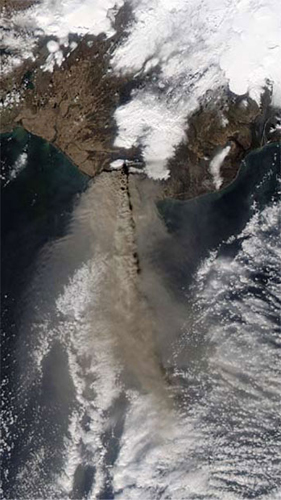
NASATrail of ash from the Eyjafjallajoekull volcano: strong particle collisions can generate dischargesNASA
For five years, the German physicists Hans Herrmann has been alternating his normal work at the famous Zurich Polytechnic School (ETH) with constant trips to the Northeast of Brazil as a visiting professor at the Federal University of Ceará (UFC). During one of these trips, the researcher observed a beautiful nocturnal spectacle produced by flashes and rays of lightning during sand storms in the dunes of Jericoacoara, in the north of Ceará. Intrigued by the unexpected electrical activity in a very dry environment which should have been a terrible current conductor, he went back home and started thinking about a phenomenon that one and a half centuries ago had already intrigued that great scientist, Michael Faraday: why does the continuous collision of grains of sand or of volcanic ash, both of them materials commonly regarded as neutral, spontaneously generate major discharges? With the help of two colleagues from ETH, Herrmann has just finished formulating an answer to this enigma, having published it in an article released on April 11 on the website of the British journal, Nature Physics.
The explanation covers an ancient contradiction, although one that the layman tends to know little about. When two electrically charged particles collide, they tend to become neutral. The negative pole of one attracts and annuls the positive one of the other. So far, so good. However, under special circumstances, as during desert sandstorms and volcanic eruptions, the collision of two particles with certain characteristics – made of the same material and electrically neutral (with the same number of positive and negative charges) paradoxically produces the opposite effect. Instead of becoming neutral, when they collide in mid-air under the effect of an external electric field, they cause a rise in the electrical charges found in this system that hitherto had appeared to be balanced. With each collision, one particle accumulates more positive charge and loses all the negative charge whereas the opposite occurs with the other particle, which progressively increases its negative charge, zeroing the positive one. Therefore, under quite specific conditions, successive collisions between grains can provoke an escalation of the system’s energy, transforming particles previously behaving like electrical isolators into conductors of large discharges. From this to an actual discharge it is just one step. “The collisions in the air increase the polarization of the grains,” explains Herrmann. “The negative charges are stored at the top of the particles and the positive ones at the base.”
In accordance with simulations conducted by computer and real experiments with grain-like particles conducted in labs, the ETCH physicists established a simplified schematic setting to explain the process whereby electric discharges appear in clouds of dust. Imagine a hypothetical cloud with only two grains of sand. When a background electrical field is applied to the system, particle charge polarization occurs. In each grain of sand, the positive charge is concentrated in the southern hemisphere and the same amount of negative charge migrates to the northern hemisphere. One must take into account that, at this moment, before any collision, the two particles, even though they are divided into two halves with the opposite electric signal, are still electrically neutral. For didactic purposes, the researchers stated that each grain carries a unit of positive charge at its base and one of negative charge at the top. When the particles collide, the southern hemisphere of one grain (with positive charge) touches the northern hemisphere (negative) of the other. This touching causes these halves to offset each other electrically: their charges become zero. However, there is a charge on the extremities of the grains that did not touch. Thus, one particle now has a unit of positive charge at its base (and zero negative charge at the top) whereas the other one has a negative charge at the top (and zero positive charge at its base).
Explosions in silos
In other words, the collision makes one grain electrically positive and the other, negative. This process, when repeated countless times in a dust cloud with thousands of particles results in an energy imbalance that may culminate as a bolt or a flash. “Our model explains the formation of electrical discharges in clouds that consist of identical particles,” states Herrmann. “If the particles were different, the principle would also apply, but the calculations would be more complicated.” There is also the issue (not yet answered) of how a background electric field arises in a sandstorm. The collisions will only energize the sand grains if there is a prior field acting upon the system.
Through an irony of nature, a few days after Herrmann and his colleagues had published their article in Nature Physics, the world witnessed the electrical discharges caused by granular particle collisions. In mid-April, the Eyjafjallajoekull volcanic glacier in Iceland began erupting. Besides bringing air traffic in most of Europe to a halt for six days, the huge trail of ash expelled by the mountain’s smoky mouth unleashed powerful bolts. “The ash from a volcano may also become electrically charged, but this only happens at the moment of the eruption, when they are strongly agitated and the particle density is high,” explains Herrmann. The grains of sand and volcanic ash are not the only particles that can become electrically charged due to repeated collisions. The phenomenon can take place and even give rise to explosions in silos containing grain, in pharmaceutical companies that process medication components and in the coal industry. In deserts, the dislocation of sand caused by a low-flying helicopter can cause dangerous flashes. Electrically charged dust has also been considered responsible for the loss of efficiency in the solar batteries used on Mars and on the Moon and, when it connects with the astronauts’ apparel, in damaging the spacesuits.
Scientific article
Pähtz, T. et al. “Why do particle clouds generate electric charges?” Nature Physics, Published online on April 11, 2010.